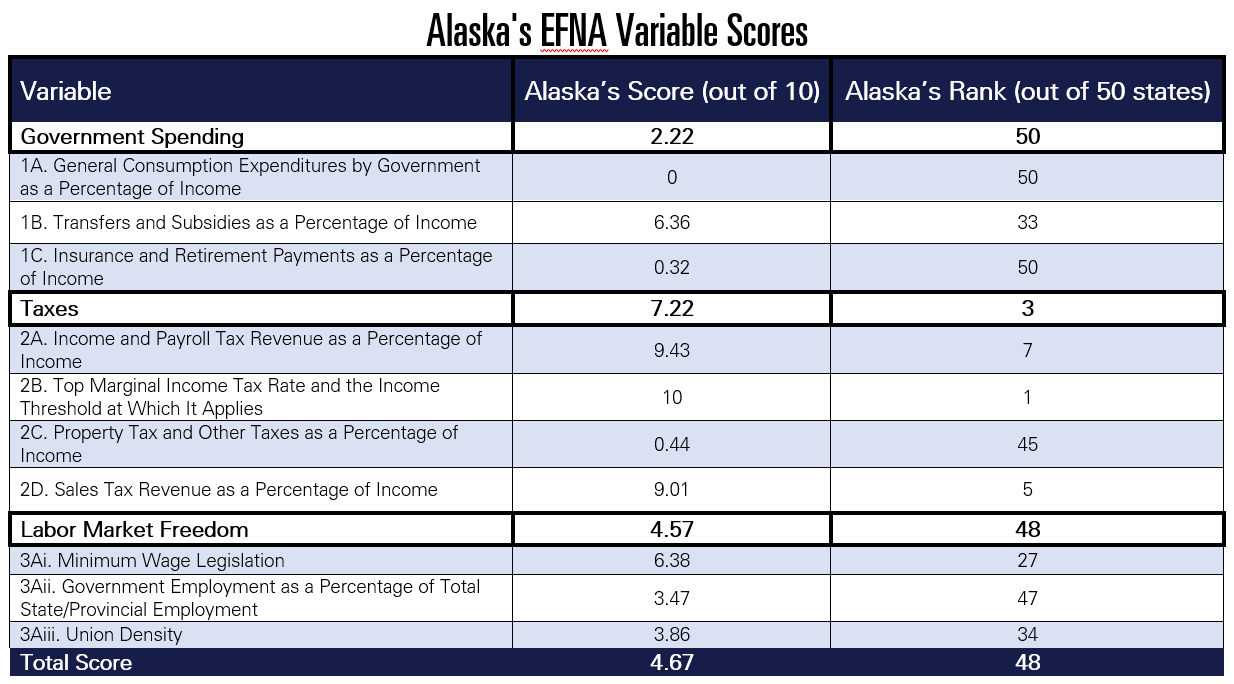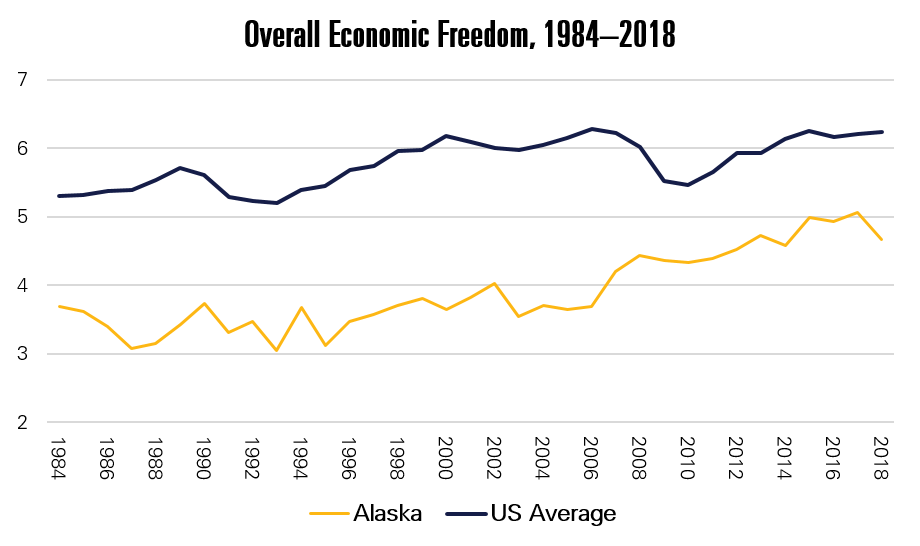 The Fraser Institute has released the updated edition of Economic Freedom of North America 2020, which examines the extent to which every state and province – in Canada, Mexico, and the United States – supported economic freedom in 2018. Unfortunately, Alaska is ranked 48th out of 50 states, which is a grim reminder that Alaska’s economic performance flags behind the rest of the country. Measuring the health of Alaska’s economy is a crucial first step to crafting targeted policy that emphasizes strengths and ameliorates weaknesses.
The Fraser Institute has released the updated edition of Economic Freedom of North America 2020, which examines the extent to which every state and province – in Canada, Mexico, and the United States – supported economic freedom in 2018. Unfortunately, Alaska is ranked 48th out of 50 states, which is a grim reminder that Alaska’s economic performance flags behind the rest of the country. Measuring the health of Alaska’s economy is a crucial first step to crafting targeted policy that emphasizes strengths and ameliorates weaknesses.
The EFNA calculates an all-government index that includes Canadian, Mexican, and U.S. subnational jurisdictions. All 10 Canadian provinces, 50 U.S. states, and 32 Mexican states are part of the index. Because the subnational indices are calculated separately for each nation, the numeric scores from the all-government index are not directly comparable to the U.S.-only index. The remainder of this article will focus on the U.S. only, but it is worth noting that Alaska placed 49th out of all 92 states and provinces, with a score of 7.84 in the all-government index, comparable to Hawaii in 48th (7.85) and Minnesota in 50th (7.82).
For each American state, the report calculates a U.S.-only index out of 10 points for economic performance in 2018, the most recent year with complete data. Intuitively, higher scores indicate a state imposing fewer restrictions on economic freedom. The index employs 10 variables in three areas: government spending, taxes, and labor market freedom, which are each rated out of 10 points. Alaska’s rankings in each of the 10 variables are in the table below as well as the total score and rank.
The government spending category is designed to determine the size of government and assess the freedom individuals have in making private choices as consumers. This category is measured by the consumption expenditures of government, transfers and subsidies, and insurance and retirement payments as a percentage of government income. The tax category assesses the tax burden on individuals that restrict private choice, as measured by income and payroll taxes, the top marginal income tax rate, property taxes, and sales taxes as a percentage of personal income. The labor market freedom category assesses the ability of employees and employers to negotiate contracts, measures union density, and attempts to estimate the degree to which high government employment crowds out private production of goods and services and makes it harder for businesses to compete in a free labor market.
Where Does Alaska Rank?
Among all 50 states, Alaska ranked 48th, with an index score of 4.67 out of 10, down from 5.05 in last year’s analysis of the 2017 data. Though Alaska also ranked 48th in the 2017 data, a decrease in absolute score indicates that freedom is declining. In the new report, Alaska falls right behind California for economic freedom (4.71), and just ahead of West Virginia in 49th place (4.50) and New York in 50th place (4.25). New Hampshire was the most economically free state with 7.84 points – a difference of 3.17 points from Alaska – which was closely followed by Florida (7.73), Virginia (7.62), Texas (7.61), and Tennessee (7.55).

Source: Economic Freedom of North America 2020, Vancouver: Fraser Institute, November 2020.
The United States ranking reveals important areas of strength and weakness for Alaska. Most notable is that Alaska ranks third in the nation in the taxes category largely because of Alaska’s current lack of a personal income tax, which sharply reduces the proportion of personal income spent on taxes. Alaska also performs the best in the nation for the top marginal income tax rate, since in a state with no personal income taxes, the highest tax rate is also 0 percent. For sales taxes, Alaska ranks fifth in the U.S., with local sales taxes but no statewide tax. Unfortunately, though many cities in Alaska do not levy property taxes, the cities that do have property taxes raise Alaska’s average property tax rate to 1.19 percent, which is higher than the national average effective property tax rate of 1.07 percent. These unusually high property taxes, which cost residents thousands of dollars in income each year, place Alaska 45th in the nation for that category, comparable with states like Vermont, Delaware, and New York.
Alaska’s labor market freedom shows substantial room for improvement, especially in the proportion of government workers compared to total state employment. Alaska ranks 47th in the nation, largely due to a high proportion of government employment compared to total state employment – about 28 percent of Alaska’s workers are employed by the government, according to 2013 Gallup research. Alaska’s union density metric evaluates the degree to which workers are required to join unions against their preference, measured through the percentage of unionized workers. Though Alaska is certainly not the worst in this metric (placing 34th), there is progress to be made to protect workers’ Janus rights and their economic freedom.
Alaska placed 50th in the government spending category – dead last in the United States – and desperately needs improvement if economic freedom is to be protected in Alaska. Though Alaska’s transfers and subsidies as a proportion of personal income are solidly middle-of-the-pack, the state government’s consumption expenditures and insurance/retirement liabilities are currently the worst in the nation. Government consumption is approximately 30 percent of total revenues, which is about double the United States average for this category. Alaska’s insurance and retirement program spending comprise about 3 percent of total revenue, which is about one-and-a-half times the United States average. Government expenditures this extreme hinder the ability of citizens to make private choices – both because government-provided services crowd out free-market provisions of these services and because citizens keep less of their money for private use.
As the chart below shows, Alaska’s economic freedom has lagged behind the rest of the nation since the earliest data was reported in 1984, but the 2018 data from the Economic Freedom of North America 2020 report reveal a rising tide lifting all boats. Though Alaska is still relatively one of the least economically-free states in the nation, absolute scores have improved since 1984. Alaska is remarkable, and the index rankings highlight why – no personal income tax and no statewide sales taxes go a long way to preserving Alaskans’ economic freedom. But by working to reduce Alaska’s government consumption, reduce insurance and retirement liabilities, and protect the rights of workers to opt-out of unions, Alaska residents could gain the economic freedom to truly thrive and flourish.
